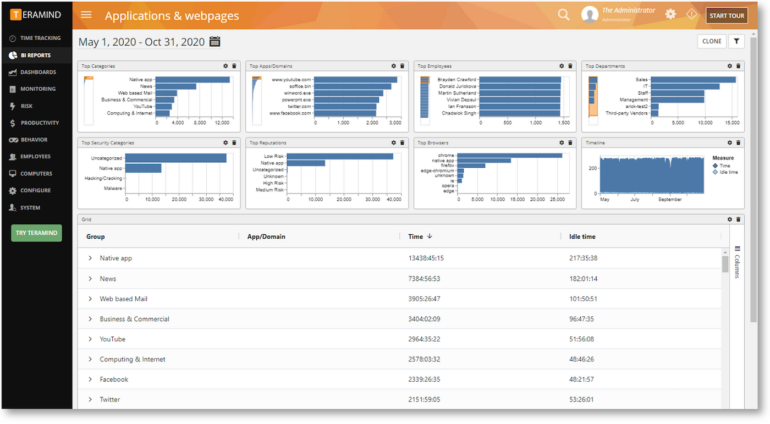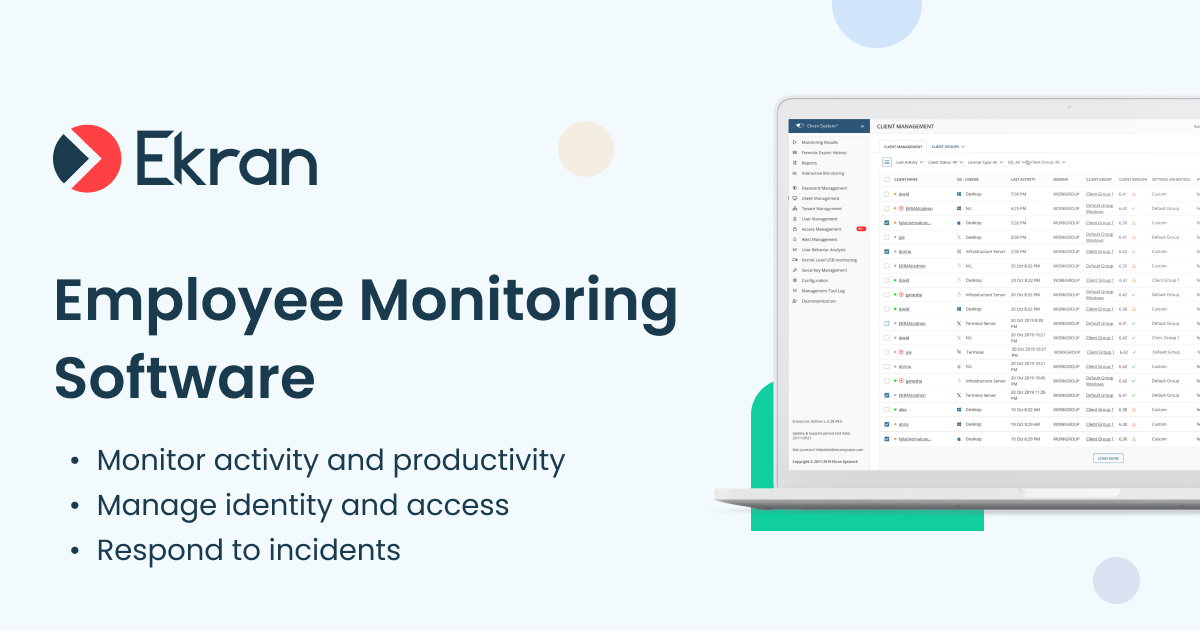The term employee monitoring software is used to refer to a software program that organizations utilize to keep track of the activities of their employees during their work. It lets employers collect information on employee activities including Internet usage keys, app usages, keystrokes or even screen shots. The primary purpose of employee monitoring software is to boost productivity, make sure that employees are in the compliance of policies, safeguard sensitive data and address concerns regarding security. When selecting an employee-monitoring software, there are several factors to consider. Here are a few important points to take into consideration features - Decide what features your company requires. These include monitoring email, activity monitoring, blocking websites keystroke recording monitoring application usage and email monitoring. Make sure you prioritize features according to the goals of your monitoring.
Compliance and Privacy - Be sure that the software adheres to ethical and legal guidelines regarding monitoring of employees. Make sure you are aware of the laws and regulations applicable to your area. This covers privacy and data protection laws. Think about software that is flexible and transparent options to protect employee privacy.
User-Friendliness- Consider the software's ease of use and accessibility. A user-friendly interface and straightforward setup process will save time and make the process easier to implement. You should look for dashboards that are customisable and reporting tools which allow you to easily understand the information collected.
Integrity and compatibility- Make sure that the application is compatible with your current IT infrastructure, which includes the operating system or email client, the project management tool, and collaboration platform. Software that is compatible guarantees continuous monitoring, and doesn't interfere with your day-to-day work.
Data Security: Evaluate the security measures of the software to ensure the security of data. Access controls and encryption and secure storage of data and compliance to industry standard security protocols are vital. Check that the provider of software has a solid security track record and has robust security practices for data.
Scalability: The software must be capable of scaling up and down according to the size of your business. Select software that is able to increase its capacity to meet the needs of your company in the event of adding more employees or new locations.
Analytical Reporting: Check the software's report and analytics capabilities. Look at features that give you a comprehensive view of employee performance, patterns and time allocation. Customized analytics and reports can help you take informed decisions and identify improvements.
Customer Support: Examine how well the vendor provides customer support. The availability of their support, the quality of support, as well as their response time are all important elements. If you have a competent customer service department They will be able to provide prompt help whenever issues occur.
Cost - Be aware of the pricing structure like an annual fee, a subscription, or dependent on the usage. Understand the pricing and if there are additional charges for support, upgrades, or other features. Be aware of the features and costs of every product.
Transparency and Employee Communication - Communicate clearly with your employees regarding the implementation of monitoring software. Be clear about the goal the scope, goals, and limitations of the monitoring. Address any concerns and make sure they understand that their privacy will still be protected.
After analyzing these elements you can make a well-informed decision that is in line with your company's particular needs and protects employees' privacy, while meeting all legal standards. Check out the recommended time tracking monitoring services for website recommendations.

What Are The Different Features Of Employee Monitoring Software?
Employee monitoring software offers a range of tools to monitor and analyze employee activities. There are a variety of features available in the employee monitoring software. The features are different based on the software used however there are a few features that you will find. It provides a thorough description of the activities employees engage in while at work.
Keystroke Logging - Keystroke recording tracks every keystroke that employees type. It is a great tool to determine productivity bottlenecks as well as identify illegal activities.
Screenshots and Screen RecordingSome software takes screenshots of employee computer screens regularly or record their screens in real-time. This feature is utilized to track the efficiency of employees, verify compliance, or troubleshoot problems.
Internet Usage Tracking- This feature tracks employees' online activities, which include the websites they visit, searches and downloads. It is able to identify excessive browsing that is not related to work, security risks, or policy violations.
This feature lets you track the applications that employees use at work. It gives insight into the applications employees most often use and assists in identifying any inappropriate or illegal usage.
Email Monitoring- Employers are able to track emails received and sent by employees, as well as attachments and the content of the email. It helps ensure compliance with policies of the company, stops data leaks, investigates any suspicious activity, and assists ensure the compliance of employees.
Tracking of documents and files This feature monitors access to, modifications of the documents, as well as transfers. It protects sensitive data tracks document collaboration, and ensures that the document is in compliance with data security guidelines.
Remote Monitoring is a feature which allows employers to keep track of their employees even when they are working from a distance or at varying locations. Employers can monitor their activities and guarantee that they work efficiently regardless of where they are.
Productivity Analysis. Employee monitoring programs often include productivity analysis features which give insight into employee work patterns and levels of productivity. These analyses help identify areas of improvement and help optimize workflow.
Reporting and Analytics - Rich analytics and reporting tools create elaborate reports that contain visualizations of the data gathered. These reports can give useful information about the performance of employees, their time allocation and resource management.
Compliance and Policy Management - Software solutions can be configured to comply with regulations, company policies, and various industry standards. Employers can establish and enforce policies pertaining to the use of computers Internet access, acceptable use of computers and data security.
Alerts and Notifications: Alerts and notifications notify employers or managers when specific situations or events occur. For example they might alert employees about excessive Internet usage, attempts at accessing restricted websites, and unusual behaviors.
Be aware that these features are included in a variety of software applications for employee monitoring. Be aware of the features offered by software that is compatible with your goals for monitoring and adhere to ethical and legal guidelines within your region. Take a look at the recommended time tracking monitoring services for site advice.

What Is The Best Software For Monitoring Employees? Adhere To Compliance And Privacy Law?
It is crucial that employee monitoring software conforms to compliance and privacy laws. Employee monitoring software must adhere to particular privacy and compliance laws. Although these laws may differ in accordance with the country of origin, some of them are generally accepted. Employee monitoring programs often include features that enable employers to effectively communicate monitoring guidelines to employees. This may include giving written notices, obtaining consent on consent forms, or creating an employee handbook that outlines monitoring procedures.
Transparent Monitoring policies- Employee monitoring policies promote transparency because they make sure employees understand what kind of information is collected, the purpose for monitoring is and how monitoring activities are executed. Employees can better know their rights to privacy and the limitations of monitoring when policies are precise and complete.
Data Minimization- To comply with privacy laws employees monitoring software usually uses data minimization techniques. Data minimization is the process of ensuring that only essential data is collected, retained and not used. This software can help reduce privacy risks by only collecting information that is required to keep track of.
Anonymization and Aggregation Some employee monitoring software anonymizes and aggregates data for further protection of privacy of employees. The process of anonymization eliminates personal information that could be identified as being personally identifiable from the collected data. It makes it impossible to associate data with a particular individual. Aggregation makes use of data from many employees to produce insights for a larger group without identifying any individuals.
Secure data storage and encryption Software for monitoring employees places the highest priority on the security of data. The software uses methods for secure storage of data and encryption to protect collected information from unauthorized access, breaches, or even accidentally released data. It is important to secure data in transit as well as in storage.
Access Controls and Restricted permissions Monitoring software for employees provides access controls with granularity to guarantee compliance. Employers can limit access to monitoring data to those who are authorized to use it for legitimate purposes for example, HR personnel or designated administrators.
Rights and Remedies for Employees Rights and Redress - Respecting rights of employees is an essential aspect of complying with privacy and compliance regulations. Most employee monitoring programs contain tools that allow employees to access their own personal information and make corrections, or even submit complaints. The software gives employees the ability to pursue recourse in the case of privacy violation and to make use of their rights.
Conformity with Data Protection Regulations – Software to monitor employee performance is developed to be in compliance with the applicable regulations. For instance, the General Data Protection Regulations of the European Union and the California Consumer Privacy Acts of the United States. Compliance involves implementing safeguards for data privacy, respecting the rights of data subjects and ensuring the legality of processing.
It is important to note that while monitoring of employees can help companies adhere to regulations and laws however, they must also consult with lawyers and remain up to date on local regulations and laws. In order to comply to privacy and compliance regulations requires an integrated strategy that goes beyond the software. This includes clear policies, employee training and constant monitoring of compliance. Take a look at the best time tracking monitoring service company for more advice.
